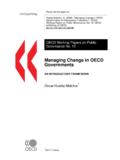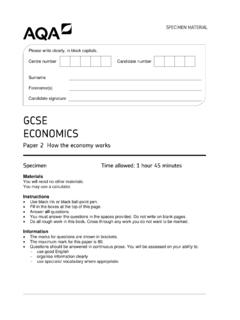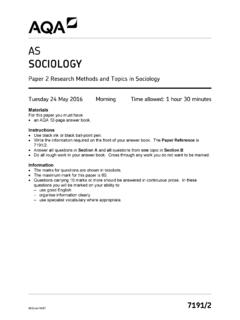Transcription of CERTIFICATE/DIPLOMA IN BUSINESS - OCR
1 THE BUSINESS ENVIRONMENTY/502/5408 LEVEL 3 UNIT 1 GUIDED LEARNING HOURS: 60 UNIT CREDIT VALUE: 10 OCR LEVEL 3 CAMBRIDGE TECHNICALCERTIFICATE/ diploma BUSINESS ENVIRONMENTY/502/5408 LEVEL 3 UNIT 1 PURPOSE OF THE UNITThis unit will help the learner to have an understanding of the range of different businesses that can exist in an economy. Learners will discover the different purposes that such organisations can have and the different forms of ownership that can exist. They will also be able to appreciate the role of the different stakeholders involved in such will have an understanding of the different ways in which businesses are organised to achieve their purposes and they will also be able to appreciate that businesses can have a variety of different unit will also help the learner to have an understanding of the way in which the wider environment can impact on businesses in terms of both the economic environment and the political, legal and social framework in which businesses are clear links between this unit and many of the other BUSINESS Environment Level 3 Unit 11 Know the range of different businesses and their ownership 2 Understand how businesses are organised to achieve their purposes3 Know the impact of the economic environment on businesses4 Know how political, legal and social factors impact on businessP1 describe the type of BUSINESS .
2 Purpose and ownership of two contrasting businessesP2 describe the different stakeholders who influence the purpose of two contrasting businessesP3 describe how two businesses are organised P4 explain how their style of organisation helps them to fulfil their describe the influence of two contrasting economic environments on BUSINESS activities within a selected organisationP6 describe how political, legal and social factors are impacting upon the BUSINESS activities of the selected organisations and their analyse the type of BUSINESS , purpose and ownership of two contrasting businesses. M2 analyse the impact of changes in demand and supply on a selected BUSINESS D1 evaluate the effect of a selected BUSINESS changing its ownership statusD2 evaluate to what extent a selected BUSINESS is likely to be affected by changes in the economic environment ASSESSMENT AND GRADING CRITERIAL earning Outcome (LO) Pass Merit Distinction The assessment criteria are To achieve a merit the To achieve a distinction the pass requirements for evidence must show that, the evidence must show this unit.
3 In addition to the pass that, in addition to the pass criteria, the learner is able to: and merit criteria, the The learner will: The learner can: learner is able to: CONTENTThe unit content describes what has to be taught to ensure that learners are able to access the highest which follows an details what must be taught as part of that area of which follows an is illustrative, it should be noted that where is used, learners must know and be able to apply relevant examples to their work though these do not need to be the same ones specified in the unit Outcome 1 Know the range of different businesses and their ownershipRange of different businesses including: local; national; European; international; global public; private; not-for-profit/voluntary/charity different BUSINESS sectors in the economy primary; secondary; purposes, ( supply goods, to provide services)Different types of ownership including: sole trader partnership (both unlimited and limited) private limited company public limited company co-operative franchise government/state owned charity/voluntary/not-for-profit impact of different types of ownership on businesses, ( the extent of liability, limitations to operation for public and not-for-profit organisations)Stakeholders, including: employees customers suppliers owners local and national communities government trade unions/employer associations the impact of different stakeholders on organisations possible conflicts of interest between different Outcome 2 Understand how businesses are organised to achieve their purposesOrganisational structures.
4 Purpose,( division of work, lines of control and communication) types of structure, ( functional, geographic, product, customer, matrix) diagrammatic representation of different types of structure (through the use of organisation charts) span of control chain of areas including: finance human resources/personnel production/operations research and development purchasing sales marketing customer service planning including: BUSINESS plan mission statement/values/vision development of strategic aims and objectives use of SMART objectives (specific, measurable, achievable, resources, time-bound) in the strategic planning factors which can impact on the organisation including: wider BUSINESS environment stakeholders BUSINESS type and aims of businesses including: profit maximisation sales revenue maximisation breakeven survival growth/increase in market share5 The BUSINESS Environment Level 3 Unit 1 quality of goods/service provision cost limitation meeting standards value for Outcome 3 Know the impact of the economic environment on BUSINESS changes in trade cycle,( boom, recession) impact of wider economy, ( inflation, unemployment) changes in government policy, ( -fiscal, such as types and levels of taxation, provision of grants and loans.)
5 Monetary, such as changes in interest rates supply-side measures, such as enhancing the skills of the working population through initiatives in education, training and research) demand curves influences on demand, ( price, price of substitutes and complements, income, advertising, tastes and preferences) elasticity of demand - price, income and cross elasticity of demand supply curves influences on supply, ( availability/cost of inputs, price, extent of government support) elasticity of supply globalisation degree of interdependence, ( supply chains, ownership of organisations, movement of factors of production) ability of national governments to regulate Outcome 4 Know how political, legal and social factors impact on businessPolitical: degree of political stability/instability change of government government support for different types of BUSINESS organisations government initiatives membership of international organisations, ( the International Monetary Fund).
6 Legal: provision of an appropriate legal framework, ( company law) consumer protection, ( Trade Descriptions Act, Sale of Goods Act) employee protection, ( Employment Act, Health and Safety at Work Act) competition, ( Competition Act) remuneration, ( Minimum Wage Act) EU : demographic issues, ( size of population, age structure of population, migration) standard of living/quality of life, ( impact of changes in income on people) attitudes to work, ( changes in attitudes to male and female roles) religion ethics and GUIDANCEL earning Outcome 1 Learners should be encouraged to focus on businesses they are already familiar with or have an interest in, for example through part-time employment, work experience or as customers. The two businesses must offer a contrast, so careful consideration should be given when selecting them. For example, the contrast might be the sector that the BUSINESS operates in; one could be in the primary sector and the other could be in the tertiary sector.
7 Alternatively, the contrast could be between a BUSINESS in the private sector and one in the public sector. This could provide a good opportunity for group work, with each group investigating different businesses in the local area and using the information they find to produce wall charts or posters to build up a visual map of the local BUSINESS should be able to distinguish between internal stakeholders, such as employees and owners, and external stakeholders, such as customers and suppliers. They should examine the influence of the different stakeholders on businesses, especially in terms of possible conflicts of interest between different parties. It might be useful if learners focused on particular issues that illustrate such conflicts. The use of local newspaper articles highlighting local issues, such as planning applications, could be used to stimulate discussions about the impact on two contrasting businesses and how their different stakeholders might feel.
8 Learning Outcome 2 Learners must understand how businesses are organised. They could be provided with the organisation charts of two businesses, and asked to identify the various functional areas that the businesses are organised into. Learners could then compare and contrast the two businesses, in terms of span of control and chain of command and discuss possible reasons for the differences. In order to develop their understanding learners could research using websites, leaflets and booklets produced by the businesses. It would also be helpful, if the learners were able to visit the two need to appreciate that the organisation of businesses is not important for its own sake, but as a means of achieving its aims and objectives. Learners could be provided with copies of mission statements from the two businesses and where a visit is possible they should try to find out as much as they can about how the two businesses organise their strategic planning.
9 The use of examples from the public and voluntary sector should enable learners to see how certain businesses involve stakeholders formally in their organisation structure, for example regulatory stakeholders such as Ofwat and Outcome 3 In earlier learning outcomes, learners were required to focus on two businesses. In learning outcome 3 they just need to be concerned with one. Learners need to understand that any BUSINESS does not exist in isolation but is affected by a range of possible economic factors. They could undertake a group task where the key economic variables that can affect a BUSINESS are identified and researched. Learners should then use the data that they have obtained and look for changes in the behaviour of businesses using examples from newspapers or news websites. Each group could then be asked to present their findings Learning Outcome 4 Learners could work in groups to research how a particular BUSINESS has been affected by political, legal and social factors, and summarise their findings in a visual form.
10 In terms of the political environment, learners should consider how governments have different policies in relation to certain BUSINESS activities. Learners also need to research any additions to the law, or changes to the existing law that could impact on businesses. Learners should also consider the social factors that can impact upon the BUSINESS activities of the selected organisations. For example, learners could consider how changes in demographics, such as the age of the population, could have a serious impact on many businesses. 7 The BUSINESS Environment Level 3 Unit 1 GUIDANCE ON ASSESSMENTP1 Learners could write a newspaper article that describes the type of BUSINESS , purpose and ownership of two contrasting should carefully select the two businesses to be compared as businesses that are very different may lead to a meaningless comparison. Ideally, the two businesses chosen should have some similarities but have sufficient differences to allow learners to progress to the merit and distinction article should include an analysis of the reasons for the differences in ownership of the two contrasting article should include and evaluation of the impact that a change in the legal structure might have on a BUSINESS Guidance: It might be advisable for learners to use a real example where possible, but a theoretical example could be could create a report that describes the different stakeholders, both internal and external, who can influence the purpose of the two contrasting and P4 Learners could produce a leaflet which describes how two businesses are organised.















